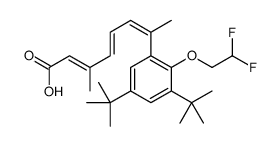| Description |
LG101506 is a selective and orally active RXR modulator with a Ki of 2.7 nM for RXRα. LG101506 can be used for the research of type 2 diabetes and cancer[1][2].
|
| Related Catalog |
|
| Target |
Ki: 2.7 nM (RXRα)[1]
|
| In Vitro |
LG101506 与 BRL 49653 (HY-17386) 协同作用增强 RXR/PPARγ 异源二聚体的激活,EC50 为 3.1 nM[1]。 LG101506 (15.6-1000 nM) 以剂量依赖的方式阻断 LPS (HY-D1056) 刺激 RAW264.7 细胞 24 小时内 NO 的产生[2]。 LG101506 (100-1000 nM; 24 h) 在 RAW264.7 细胞中抑制 LPS (HY-D1056) 或 TNFα 诱导的炎症通路[2]。 LG101506 (30 and 100 nM; 1-24 h) 诱导 U937 白血病细胞分化[2]。 Western Blot Analysis[2] Cell Line: RAW264.7 cells Concentration: 100, 300 and 1000 nM Incubation Time: 24 h Result: Markedly reduced protein levels of COX-2. Pretreatment prevented the degradation of IκBα in RAW cells stimulated with TNFα. Enhanced Erk phosphorylation, which peaked at 8 hours. Western Blot Analysis[2] Cell Line: U937 leukemia cells Concentration: 30 and 100 nM Incubation Time: 1, 2, 8 and 24 h Result: Enhanced phosphorylation of Akt in U937 cells within 1 hour, which increased further at 8 hours.
|
| In Vivo |
LG101506 (10 mg/kg; in diet for 16 weeks) 抑制 A/J 小鼠肺癌的发生[2]。 Animal Model: A/J mice, lung carcinogenesis model[2] Dosage: 40 mg/kg diet or approximately 10 mg/kg body weight Administration: Oral, for 16 weeks Result: Reduced the number of lung tumors, the average tumor burden, the size and histopathology of lung tumors. Animal Model: Male ICR mice[1] Dosage: 30 mg/kg Administration: Oral (Pharmacokinetic Analysis) Result: In vivo evaluation of oral exposure of LG101506[1] Compd Dose (mg/kg) Oral AUC(0-6 h) (μg•h/mL) Tmax (h) Cmax (μg•h/mL) LG101506 30 2.09±0.45 1 1.2±0.28 Data collected in male ICR mouse using a dose formulation of the free acid in CMC/SLS/Povidone (30 mg/kg). Timepoints: 1, 3, 8 h (serial sacrifice, n=3/time point).
|
| References |
[1]. Gernert DL, et al. Design and synthesis of fluorinated RXR modulators. Bioorg Med Chem Lett. 2003 Oct 6;13(19):3191-5. [2]. Cao M, et al. The Rexinoids LG100268 and LG101506 Inhibit Inflammation and Suppress Lung Carcinogenesis in A/J Mice. Cancer Prev Res (Phila). 2016 Jan;9(1):105-14.
|
